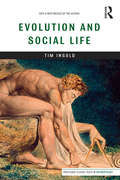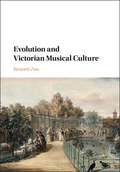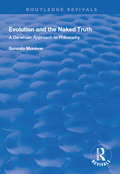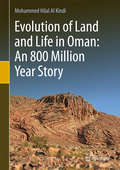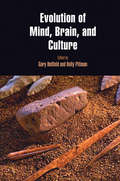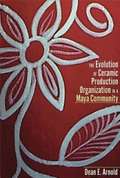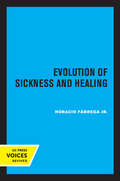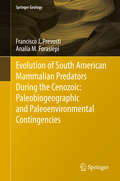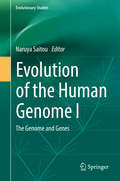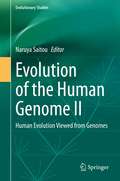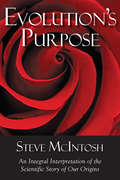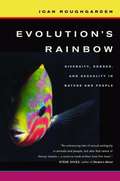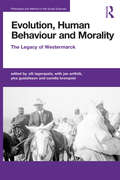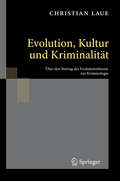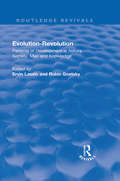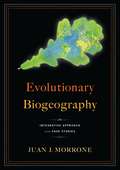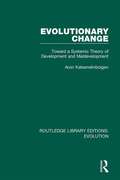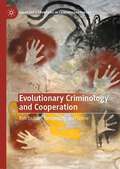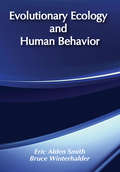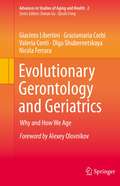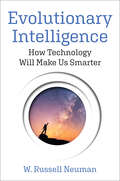- Table View
- List View
Evolution and Rationality
by Samir Okasha Ken BinmoreThis volume explores from multiple perspectives the subtle and interesting relationship between the theory of rational choice and Darwinian evolution. In rational choice theory, agents are assumed to make choices that maximize their utility; in evolution, natural selection 'chooses' between phenotypes according to the criterion of fitness maximization. So there is a parallel between utility in rational choice theory and fitness in Darwinian theory. This conceptual link between fitness and utility is mirrored by the interesting parallels between formal models of evolution and rational choice. The essays in this volume, by leading philosophers, economists, biologists and psychologists, explore the connection between evolution and rational choice in a number of different contexts, including choice under uncertainty, strategic decision making and pro-social behaviour. They will be of interest to students and researchers in philosophy of science, evolutionary biology, economics and psychology.
Evolution and Social Life (Routledge Classic Texts in Anthropology)
by Tim IngoldEvolution is among the most central and most contested of ideas in the history of anthropology. This book charts the fortunes of the idea from the mid-nineteenth century to recent times. By comparing biological, historical, and anthropological approaches to the study of human culture and social life, it lays the foundation for their effective synthesis. Far ahead of its time when first published, the book anticipates debates at the forefront of contemporary thinking. Revisiting the work after almost thirty years, Tim Ingold offers a substantial new preface that describes how the book came to be written, how it was received and its bearing on later developments. Unique in scope and breadth of theoretical vision, Evolution and Social Life cuts across the boundaries of natural science and the humanities to provide a major contribution both to the history of anthropological and social thought, and to contemporary debate on the relationship between human nature, culture, and social life.
Evolution and Victorian Culture
by Bernard Lightman Bennett ZonIn this collection of essays from leading scholars, the dynamic interplay between evolution and Victorian culture is explored for the first time, mapping new relationships between the arts and sciences. Rather than focusing simply on evolution and literature or art, this volume brings together essays exploring the impact of evolutionary ideas on a wide range of cultural activities including painting, sculpture, dance, music, fiction, poetry, cinema, architecture, theatre, photography, museums, exhibitions and popular culture. Broad-ranging, rather than narrowly specialized, each chapter provides a brief introduction to key scholarship, a central section exploring original insights drawn from primary source material, and a conclusion offering overarching principles and a projection towards further areas of research. Each chapter covers the work of significant individuals and groups applying evolutionary theory to their particular art, both as theorists and practitioners. This comprehensive examination of topics sheds light on larger and previously unknown Victorian cultural patterns.
Evolution and Victorian Musical Culture
by Bennett ZonThis engaging book explores the dynamic relationship between evolutionary science and musical culture in Victorian Britain, drawing upon a wealth of popular scientific and musical literature to contextualize evolutionary theories of the Darwinian and non-Darwinian revolutions. Bennett Zon uses musical culture to question the hegemonic role ascribed to Darwin by later thinkers, and interrogates the conceptual premise of modern debates in evolutionary musicology. Structured around the Great Chain of Being, chapters are organized by discipline in successively ascending order according to their object of study, from zoology and the study of animal music to theology and the music of God. Evolution and Victorian Musical Culture takes a non-Darwinian approach to the interpretation of Victorian scientific and musical interrelationships, debunking the idea that the arts had little influence on contemporary scientific ideas and, by probing the origins of musical interdisciplinarity, the volume shows how music helped ideas about evolution to evolve.
Evolution and the Naked Truth: Darwinian Approach to Philosophy (Routledge Revivals)
by Gonzalo MunevarPublished in 1998, the main aim of this book is to use a naturalistic, evolutionary approach to solve some of the most important problems in philosophy. The first two problems come from the philosophy of science: the problem of rationality of science and the problem of truth in science. In presenting the first problem, the author argues that the views of Kuhn and Feyerabend do create a very serious challenge to traditional epistemology, however, if the assumption of individual rationality is abandoned in favour of the author's social concept of rationality, a committed naturalism can account for science as a rational activity. In tackling the second problem of truth, the author shows that a committed evolutionary philosophy does not support realism but leads instead to a thorough evolutionary relativism of scientific knowledge. It is nevertheless possible to use this evolutionary relativism to construct a theory of relative truth. The issue of whether science discovers truth has also been tied to absolutism, that a well formulated theory of relative truth is likely to bring about a profound transformation of the way we think about the field. The author explores the notion of relative truth in the philosophy of science, ethics and aesthetics.
Evolution of Land and Life in Oman: an 800 Million Year Story
by Mohammed Hilal Al KindiThis book takes readers on a fascinating journey to discover the story of land and ancient life evolution in Oman since at least 800 million years ago. Oman is well known for its marvelous geology. What tectonics affected this part of the world and what organisms lived there? How did the climate and life develop? Did life forms become more complex and varied or become extinct and disappear forever? The book thoroughly reconstructs this land and ancient life evolution and offers readers an understanding on how land, climate and life have proceeded and developed in Oman through the millions of years.
Evolution of Mind, Brain, and Culture
by Holly Pittman Gary HatfieldDescartes boldly claimed: "I think, therefore I am." But one might well ask: Why do we think? How? When and why did our human ancestors develop language and culture? In other words, what makes the human mind human?Evolution of Mind, Brain, and Culture offers a comprehensive and scientific investigation of these perennial questions. Fourteen essays bring together the work of archaeologists, cultural and physical anthropologists, psychologists, philosophers, geneticists, a neuroscientist, and an environmental scientist to explore the evolution of the human mind, the brain, and the human capacity for culture. The volume represents and critically engages major theoretical approaches, including Donald's stage theory, Mithen's cathedral model, Tomasello's joint intentionality, and Boyd and Richerson's modeling of the evolution of culture in relation to climate change.No recent publication combines this breadth of evidential and theoretical perspective. The essays range in topic from the macroscopic (the evolution of social cooperation) to the microscopic (examining genetic data to infer evolutions in brain structure and function), and from the ancient (paleoanthropological reconstructions of hominin cognitive abilities) to the modern (including modern hominin's similarities to our primate cousins). Considered together, these essays constitute a fascinating, detailed look at what makes us human.PMIRC, volume 5
Evolution of Production Organization in a Maya Community
by Dean E. ArnoldIn The Evolution of Production Organization in a Maya Community, Dean E. Arnold continues his unique approach to ceramic ethnoarchaeology, tracing the history of potters in Ticul, Yucatán, and their production space over a period of more than four decades. This follow-up to his 2008 work Social Change and the Evolution of Ceramic Production and Distribution uses narrative to trace the changes in production personnel and their spatial organization through the changes in production organization in Ticul.Although several kinds of production units developed, households were the most persistent units of production in spite of massive social change and the reorientation of pottery production to the tourist market. Entrepreneurial workshops, government-sponsored workshops, and workshops attached to tourist hotels developed more recently but were short-lived, whereas pottery-making households extended deep into the nineteenth century. Through this continuity and change, intermittent crafting, multi-crafting, and potters' increased management of economic risk also factored into the development of the production organization in Ticul.Illustrated with more than 100 images of production units, The Evolution of Production Organization in a Maya Community is an important contribution to the understanding of ceramic production. Scholars with interests in craft specialization, craft production, and demography, as well as specialists in Mesoamerican archaeology, anthropology, history, and economy, will find this volume especially useful.
Evolution of Sickness and Healing
by Horacio Fábrega Jr.Evolution of Sickness and Healing is a theoretical work on the grand scale, an original synthesis of many disciplines in social studies of medicine. Looking at human sickness and healing through the lens of evolutionary theory, Horacio Fàbrega, Jr. presents not only the vulnerability to disease and injury but also the need to show and communicate sickness and to seek and provide healing as innate biological traits grounded in evolution. This linking of sickness and healing, as inseparable facets of a unique human adaptation developed during the evolution of the hominid line, offers a new vantage point from which to examine the institution of medicine. To show how this complex, integrated adaptation for sickness and healing lies at the root of medicine, and how it is expressed culturally in relation to the changing historical contingencies of human societies, Fàbrega traces the characteristics of sickness and healing through the early and later stages of social evolution. Besides offering a new conceptual structure and a methodology for analyzing medicine in evolutionary terms, he shows the relevance of this approach and its implications for the social sciences and for medical policy. Health scientists and medical practitioners, along with medical historians, economists, anthropologists, and sociologists, now have the opportunity to consider every essential aspect of medicine within an integrated framework. This title is part of UC Press's Voices Revived program, which commemorates University of California Press's mission to seek out and cultivate the brightest minds and give them voice, reach, and impact. Drawing on a backlist dating to 1893, Voices Revived makes high-quality, peer-reviewed scholarship accessible once again using print-on-demand technology. This title was originally published in 1997.
Evolution of South American Mammalian Predators During the Cenozoic: Paleobiogeographic and Paleoenvironmental Contingencies
by Francisco J. Prevosti Analía M. ForasiepiThis book summarizes the evolution of carnivorous mammals in the Cenozoic of South America. It presents paleontological information on the two main mammalian carnivorous groups in South America; Metatheria and Eutheria. The topics include the origin, systematics, phylogeny, paleoecology and evolution of the Sparassodonta and Carnivora. The book is based on a wide variety of published sources from the last few decades.
Evolution of the Human Genome I
by Naruya SaitouThis book reviews the human genome from an evolutionary perspective. No such book has ever been published before, although there are many books on human genomes. There are two parts in this book: Overview of the Human Genome (Part I) and The Human Genome Viewed through Genes (Part II). In Part I, after a brief review of human evolution and the human genome (by Naruya Saitou), chapters on rubbish or junk DNA (by Dan Graur), GC content heterogeneity (by Satoshi Oota), protein coding and RNA coding genes (by Tadashi Imanishi), duplicated genes (by Takashi Kitano), recombinations (by Montanucci and Bertranpetit), and copy number variations including microsatellites (by Naoko Takezaki) are discussed. Readers can obtain various new insights on the human genome from this part. In Part II, genes in X and Y chromosomes (by Yoko Satta and others), HLA genes (by Timothy A. Jinam), opsin genes (by Shoji Kawamura and Amanda D. Melin), genes related to phenotypic variations (by Ryosuke Kimura), transcription factors (by Mahoko Takahashi and So Nakagawa), diabetes-related genes (by Ituro Inoue), disease genes in general (by Ituro Inoue and Hirofumi Nakaoka), and microbial genomes (by Chaochun Wei) are discussed. The human genome sequences were determined in 2004, and after more than 10 years we are now beginning to understand the human genome from an evolutionary point of view. This book furnishes readers with a good summary of current research in the field.
Evolution of the Human Genome II: Human Evolution Viewed from Genomes (Evolutionary Studies)
by Naruya SaitouThis two-volume set provides a general overview of the evolution of the human genome; The first volume overviews the human genome with descriptions of important gene groups. This second volume provides up-to-date, concise yet ample knowledge on the genome evolution of modern humans. It comprises twelve chapters divided into two parts discussing “Non-neutral Evolution on Human Genes” (Part I) and “Evolution of Modern Human Populations” (Part II.) The most significant feature of this book is the continent-wise discussion of modern human dispersal using human genomic data in Part II. Recent results such as introgression of paleogenomes to modern humans, new methods such as computer simulation of global human dispersals, and new information on genes for humanness will be of particular interest to the readers. Since the euchromatin regions of the human genome was sequenced in 2003, a huge number of research papers were published on modern human evolution for a variety of populations. It is now time to summarize these achievements. This book stands out as the most comprehensive book on the modern human evolution, focusing on genomic points of view with a broad scope. Primary target audiences are researchers and graduate students in evolutionary biology.
Evolution's Purpose
by Steve McintoshDoes the science of evolution really prove that life, humanity, and the universe as a whole are meaningless accidents? On the contrary, as science has increasingly shown how everything in the universe is subject to evolution-including matter, life, and human culture-these very facts reveal that the process of evolution is unmistakably progressive. As we come to see how evolution has progressed throughout our cosmology, biology, and human culture, this reveals evolution's purpose-to grow toward ever-widening realizations of beauty, truth, and goodness. McIntosh argues that the purpose of evolution is not "intelligently designed" or otherwise externally controlled; rather, its purpose is being creatively and originally discerned through the choices of evolutionary creatures themselves. Without relying on any spiritual authorities, the author shows how the scientific story of our origins is actually a profound and sacred teaching compatible with many forms of contemporary spirituality. In EVOLUTION'S PURPOSE, McIntosh discusses:* Science's growing recognition of the phenomenon of emergence, which ties together all forms of evolution* Why traditional philosophies no longer adequately explain the fullness of evolution* Why the idea that evolution is accidental or meaningless is just as mythical as the idea that the world was created in six days* Why growth toward beauty, truth, and goodness harmonizes with scientific truth* Reconciling evolution's purpose with the presence of evil and suffering in the world Taking us from pre-biotic forms of life right up through the development of human consciousness and our global civilization, McIntosh presents a fresh and compelling view of evolutionary science and philosophy that will inspire a deeper understanding of evolution itself and show how it can lead directly to a more evolved world.
Evolution's Rainbow: Diversity, Gender, and Sexuality in Nature and People
by Joan RoughgardenA celebration of the enormous diversity of genders and sexuality found in animals and among human cultures. Roughgarden explores how and why this range of bodies and behaviors evolved and exposes how biology, medicine, anthropology and Christianity have obstructed the recognition and acceptance of this diversity.
Evolution, Human Behaviour and Morality: The Legacy of Westermarck (Philosophy and Method in the Social Sciences)
by Olli Lagerspetz Jan Antfolk Ylva Gustafsson Camilla KronqvistThis book highlights the recent re-emergence of Edward Westermarck's work in modern approaches to morality and altruism, examining his importance as one of the founding fathers of anthropology and as a moral relativist, who identified our moral feelings with biologically-evolved retributive emotions. Questioning the extent to which current debates on the relationship between biology and morality are similar to those in which Westermarck himself was involved, the authors ask what can be learnt from his arguments and from the criticism that he encountered. Drawing on Westermarck's manuscripts and papers as well as his published work, the authors show the importance of situating debates, whether modern or classical, in their correct methodological and philosophical context. This volume is a rigorous assessment of the ways in which morality is connected with human biological nature. It plays close attention to the development of debates in this field and will appeal to scholars of sociology, anthropology and philosophy.
Evolution, Human Behaviour and Morality: The Legacy of Westermarck (Philosophy and Method in the Social Sciences)
by Olli Lagerspetz Jan Antfolk Ylva Gustafsson Camilla KronqvistThis book highlights the recent re-emergence of Edward Westermarck's work in modern approaches to morality and altruism, examining his importance as one of the founding fathers of anthropology and as a moral relativist, who identified our moral feelings with biologically-evolved retributive emotions.Questioning the extent to which current debates on the relationship between biology and morality are similar to those in which Westermarck himself was involved, the authors ask what can be learnt from his arguments and from the criticism that he encountered. Drawing on Westermarck's manuscripts and papers as well as his published work, the authors show the importance of situating debates, whether modern or classical, in their correct methodological and philosophical context.This volume is a rigorous assessment of the ways in which morality is connected with human biological nature. It plays close attention to the development of debates in this field and will appeal to scholars of sociology, anthropology and philosophy.
Evolution, Kultur und Kriminalität
by Christian LaueDie Evolutionsbiologie gilt einerseits als Königsdisziplin der Biologie, andererseits wird sie nach den erschreckenden Erfahrungen mit der Kriminalbiologie vor allem mit Eugenik, Sozialdarwinismus und Rassismus in Verbindung gebracht. Tatsächlich bietet die Evolutionstheorie viele Antworten auf kriminologisch interessante Fragen. Der Autor überbrückt den Graben zwischen sozialwissenschaftlich orientierter Kriminologie und den Biowissenschaften und untersucht, inwieweit neue Erkenntnisse aus der Evolutionsbiologie die Kriminologie bereichern können.
Evolution, Race and Public Spheres in India: Vernacular Concepts and Sciences (1860-1930) (Routledge Studies in South Asian History)
by Luzia SavaryThis book provides an in-depth exploration of South Asian readaptations of race in vernacular languages. The focus is on a diverse set of printed texts, periodicals and books in Hindi and Urdu, two of the major print languages of British North India, written between 1860 and 1930. Imperial raciology is a burgeoning field of historical research. So far, most studies on race in the British Empire in South Asia have concentrated on the writings of Western-educated elites in English. The range of Hindi and Urdu sources analyzed by the author provides a more varied and complex picture of the ways in which South Asians reinterpreted racial concepts, thereby highlighting the importance of scrutinizing the vernacular dimensions of global entanglements. Part I of the book centers on the debates on "civilization" and "civility" in Hindi and Urdu periodicals, travelogues and geography books as well as Hindi literature on caste. It asks if and in what respect the discussions changed when authors appropriated racial concepts. Part II revolves around the "science" of eugenics. It scrutinizes more popular genres, namely, early twentieth century advisory literature on "fit reproduction." It highlights how the knowledge promoted there was different from "eugenics" as the (mainly English-writing) founders of the Indian eugenic movements endorsed it. A fascinating analysis of the ways in which colonized elites have adopted and readapted racial concepts and theories, this book will be of interest to academics in the fields of Modern South Asian History, History of Science, Critical Race Studies and Colonial and Imperial History.
Evolution-Revolution: Patterns of Development in Nature Society, Man and Knowledge (Routledge Revivals)
by Ervin Laszlo Rubin GoetskyOriginally published in 1971 Evolution – Revolution is an interdisciplinary volume examining inquiry around the central topic of evolution and revolution. Containing contributions from a number of eminent academics of the time, the book addresses the meaning and application of evolution and revolution in the context, not of what things are, or even how they behave, but how they become. The broad interdisciplinary range of essays explores this concept through the idea of development and change and argues that both change, and development must be measured against concepts of flux and that which endures. The editors of the book suggest that these are the ‘invariants’ which contemporary thinkers are beginning to accept as the process-counterparts of Platonic ‘immutables’. Thus this volume examines the two ‘immutables’ of evolution and revolution. The book covers the concept through essays in science, philosophic concepts of rationalism and existentialism, art and religion.
Evolutionary Biogeography: An Integrative Approach with Case Studies (Crc Biogeography Ser.)
by Juan MorroneRather than favoring only one approach, Juan J. Morrone proposes a comprehensive treatment of the developments and theories of evolutionary biogeography. Evolutionary biogeography uses distributional, phylogenetic, molecular, and fossil data to assess the historical changes that have produced current biotic patterns. Panbiogeography, parsimony analysis of endemicity, cladistic biogeography, and phylogeography are the four recent and most common approaches. Many conceive of these methods as representing different "schools," but Morrone shows how each addresses different questions in the various steps of an evolutionary biogeographical analysis. Panbiogeography and parsimony analysis of endemicity are useful for identifying biotic components or areas of endemism. Cladistic biogeography uses phylogenetic data to determine the relationships between these biotic components. Further information on fossils, phylogeographic patterns, and molecular clocks can be incorporated to identify different cenocrons. Finally, available geological knowledge can help construct a geobiotic scenario that may explain how analyzed areas were put into contact and how the biotic components and cenocrons inhabiting them evolved. Morrone compares these methods and employs case studies to make it clear which is best for the question at hand. Set problems, discussion sections, and glossaries further enhance classroom use.
Evolutionary Change: Toward a Systemic Theory of Development and Maldevelopment (Routledge Library Editions: Evolution #5)
by Aron KatsenelinboigenOriginally published in 1997 Evolutionary Change addresses the somatic mechanism of change. Although astounding advances in molecular biology have opened up new engineering possibilities to shape our future in terms of "improving" the human species as well as eradicating all kinds of pathological characteristics of biological development, these possibilities pose potentially serious dangers. They arise primarily from the local nature of changes that are introduced and the impact of the environment on the overall development of the biological system. The book explores the biological mechanisms of change in their entirety – as they fit into the general dynamics of biological systems – and demonstrates the pitfalls of tackling change from a narrow perspective, using cancer as an example of certain pathological manifestations of these mechanisms of change.
Evolutionary Criminology and Cooperation: Retribution, Reciprocity, and Crime (Palgrave's Frontiers in Criminology Theory)
by Evelyn SvingenThis book develops an evolutionary theory of crime. Both evolutionary theory and neurocriminology are growing fields that are attracting more and more interest for criminologists and wider fields alike. This book summarises important readings that relate to retribution and punishment and presents some neurocriminological findings. In addition, the book introduces a new methodology for the study of crime: a game theory experiment adapted from the field of behavioural economics. Overall, the book synthesises the key crime literature, presents a new theory of crime in a new field of evolutionary criminology and the methodology to study it, and provides empirical results in support of the theory. For any evolutionary and neuroscientist interested in deviance, this book offers a new model which is testable using more complex methods such as MRI scanners and survival simulations.
Evolutionary Ecology and Human Behavior (Foundations Of Human Behaviour Ser.)
by Eric Alden Smith""à required reading for anyone interested in the economy, ecology, and demography of human societies."" --American Journal of Human Biology ""This excellent book can serve both as a text¼book and as a scholarly reference."" --American Scientist
Evolutionary Gerontology and Geriatrics: Why and How We Age (Advances in Studies of Aging and Health #2)
by Giacinto Libertini Graziamaria Corbi Valeria Conti Olga Shubernetskaya Nicola FerraraThis book provides concrete scientific basis that we can conceive the possibility of modifying or even completely canceling aging process, despite the fact that aging is commonly regarded as the result of the overall effects of many uncontrollable degenerative phenomena. The authors illustrate in detail the mechanisms by which cells and the whole organism age. Actions by which it is possible, or will be possible within a limited time, to operate for modifying aging are also debated.The discussion is conducted within the frame and the concepts of evolutionary medicine, which is also indispensable for distinguishing between the manifestations of aging and: (i) diseases that worsen with age, and (ii) acceleration of normal aging rates, caused by unhealthy lifestyle habits and other avoidable factors. The book also discusses the impact of aging on overall mortality and the strange situation that, according to official statistics, aging does not exist as cause of death.This book is a turning point between a gerontology and geriatrics conceived as the study and vain treatment of an incurable condition and one in which these disciplines examine the how and why of a physiological phenomenon that can be modified up to a possible total control. This means transforming the medical prevention and treatment of physiological aging from the greatest failure to the greatest success of medicine.
Evolutionary Intelligence: How Technology Will Make Us Smarter
by W. Russell NeumanA surprising vision of how human intelligence will coevolve with digital technology and revolutionize how we think and behave.It is natural for us to fear artificial intelligence. But does Siri really want to kill us? Perhaps we are falling into the trap of projecting human traits onto the machines we might build. In Evolutionary Intelligence, Neuman offers a surprisingly positive vision in which computational intelligence compensates for the well-recognized limits of human judgment, improves decision making, and actually increases our agency. In artful, accessible, and adventurous prose, Neuman takes the reader on an exciting, fast-paced ride, all the while making a convincing case about a revolution in computationally augmented human intelligence.Neuman argues that, just as the wheel made us mobile and machines made us stronger, the migration of artificial intelligence from room-sized computers to laptops to our watches, smart glasses, and even smart contact lenses will transform day-to-day human decision making. If intelligence is the capacity to match means with ends, then augmented intelligence can offer the ability to adapt to changing environments as we face the ultimate challenge of long-term survival.Tapping into a global interest in technology&’s potential impacts on society, economics, and culture, Evolutionary Intelligence demonstrates that our future depends on our ability to computationally compensate for the limitations of a human cognitive system that has only recently graduated from hunting and gathering.

